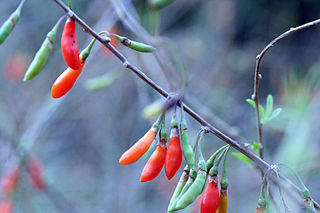
Bai Chongxi was a Chinese general in the National Revolutionary Army of the Republic of China (ROC) and a prominent Chinese Nationalist leader. He was of Hui ethnicity and of the Muslim faith. From the mid-1920s to 1949, Bai and his close ally Li Zongren ruled Guangxi province as regional warlords with their own troops and considerable political autonomy. His relationship with Chiang Kai-shek was at various times antagonistic and cooperative. He and Li Zongren supported the anti-Chiang warlord alliance in the Central Plains War in 1930, then supported Chiang in the Second Sino-Japanese War and the Chinese Civil War. Bai was the first defense minister of the Republic of China from 1946-48. After losing to the Communists in 1949, he fled to Taiwan, where he died in 1966.

Glaresis is a genus of beetles, sometimes called "enigmatic scarab beetles", in its own family, the Glaresidae. It is closely related to, and was formerly included in, the family Scarabaeidae. Although its members occur in arid and sandy areas worldwide, only the nocturnal adults have ever been collected, and both the larvae and biology of Glaresis are as yet unknown. Due to their narrow habitat associations, a great number of these species occur in extremely limited geographic areas, and are accordingly imperiled by habitat destruction.

Phellodendron, or cork-tree, is a genus of deciduous, dioecious trees in the family Rutaceae, native to east and northeast Asia. It has leathery, pinnate leaves and yellow, clumped flowers. The name refers to the thick and corky bark of some species in the genus.

Goji, goji berry, or wolfberry, is the fruit of either Lycium barbarum or Lycium chinense, two closely related species of boxthorn in the nightshade family, Solanaceae. L. barbarum and L. chinense fruits are similar but can be distinguished by differences in taste and sugar content.

Capsicum chinense, commonly known as a "habanero-type pepper", is a species of chili pepper native to the Americas. C. chinense varieties are well known for their unique flavors and many have exceptional heat. The hottest peppers in the world are members of this species, with Scoville Heat Unit scores of over 2 million. Some taxonomists consider them to be part of the species C. annuum, and they are a member of the C. annuum complex; however, C. chinense and C. annuum pepper plants can sometimes be distinguished by the number of flowers or fruit per node – two to five for C. chinense and one for C. annuum – though this method is not always correct. The two species can also hybridize and generate inter-specific hybrids. It is believed that C. frutescens is the ancestor to the C. chinense species.

Lycium chinense is one of two species of boxthorn shrub in the family Solanaceae. Along with Lycium barbarum, it produces the goji berry ("wolfberry"). Two varieties are recognized, L. chinense var. chinense and L. chinense var. potaninii. It is also known as Chinese boxthorn, Chinese matrimony-vine, Chinese teaplant, Chinese wolfberry, wolfberry, and Chinese desert-thorn.

Phellodendron amurense is a species of tree in the family Rutaceae, commonly called the Amur cork tree. It is a major source of huáng bò, one of the 50 fundamental herbs used in traditional Chinese medicine. The Ainu people used this plant, called shikerebe-ni, as a painkiller. It is known as hwangbyeok in Korean and (キハダ) kihada in Japanese.

Dit da jow is a common Chinese liniment used as a folk remedy to supposedly heal external injuries, such as bruises or sore muscles.

Allium chinense is an edible species of Allium, native to China, and cultivated in many other countries. Its close relatives include the onion, shallot, leek, chive, and garlic.
After the founding of the Republic of China, Guangxi served as the base for one of the most powerful warlord cliques of China: the Old Guangxi clique. Led by Lu Rongting (陆荣廷) and others, the clique was able to take control of neighbouring Hunan and Guangdong provinces as well. The Old Guangxi clique crumbled in the early 1920s, and was replaced by the New Guangxi clique, led by Li Zongren, Huang Shaohong, and Bai Chongxi.

Phellamurin, a flavonoid, is the 7-O-β-D-glucopyranoside, 8-C-prenyl derivative of the flavan-on-ol Aromadendrin, and may be seen as the 7-O-glucoside of noricaritin. Being a flavanonol, it has two stereocenters on the C-ring, so four stereoisomers of phellamurin are possible.
Sān miào wán is a traditional Chinese medicine consisting of three components:

Huáng bǎi, huáng bó (黃柏) or huáng bò (黃檗) is one of the fifty fundamental herbs of traditional Chinese medicine. Known also as Cortex Phellodendri, it is the bark of one of two species of Phellodendron tree: Phellodendron amurense or Phellodendron chinense.

Isocoumarin is a lactone, a type of natural organic compound.
The Wulong Karst is a karst landscape located within the borders of Wulong District, Chongqing Municipality, People's Republic of China. It is divided into three areas containing the Three Natural Bridges, the Qingkou Tiankeng (箐口天坑) and Furong Cave respectively. It is a part of the Wulong Karst National Geology Park as well as part of the South China Karst, a UNESCO World Heritage Site.

The Hainan yellow lantern chili, also known as the yellow emperor chili is a member of the Capsicum chinense species of chili peppers that grows mainly in the southwest and southeast of Hainan Island off the coast of Southern China.
P. chinense may refer to:

Ethyl caffeate is an ester of a hydroxycinnamic acid, a naturally occurring organic compound.

Hypericum annulatum is a species of flowering plant in the family Hypericaceae. It is closely related to Hypericum montanum which is its sister species.















